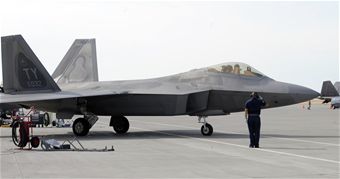| |
| |
 |
MOUNTAIN HOME AIR FORCE BASE, Idaho -- Senior Airman Dez Watson, 43rd Aircraft Maintenance Unit crew chief, out of Tyndall AFB, Fla., salutes an F-22 Raptor as it taxis toward the Mountain Home AFB runway Aug 6. More than 150 Airmen and 12 F-22 Raptors from the 43rd Fighter Squadron at Tyndall Air Force Base, Fla., arrived here July 31 in support of the Air Force's first Exercise Global Gem joint training. (U.S. Air Force photo/Airman 1st Class Debbie Lockhart)
|
 |
MOUNTAIN HOME AIR FORCE BASE, Idaho -- Lt. Col. Bradley Bird, 43rd Fighter Squadron commander and F-22 pilot, is interviewed about Exercise Global Gem during a media visit here Aug. 6. More than 150 Airmen and 12 F-22 Raptors from Tyndall Air Force Base, Fla., began a five-week training mission here with the 389th FS on Aug. 2. (U.S. Air Force photo/Airman 1st Class Debbie Lockhart)
|
 |
MOUNTAIN HOME AIR FORCE BASE, Idaho -- Senior Airman Dez Watson, 43rd Aircraft Maintenance Unit crew chief, out of Tyndall AFB, Fla., updates information to a Toughbook on the Mountain Home AFB flightline Aug 6. The airspace and terrain in the local area allows the F-22 to employ air-to-air and air-to-ground capabilities in mountainous areas, which greatly differ from the coastal and water areas where they typically conduct their training. (U.S. Air Force photo/Airman 1st Class Debbie Lockhart)
|
 |
MOUNTAIN HOME AIR FORCE BASE, Idaho -- Capt. Jessica Hietpas, 389th Fighter Squadron F-15E pilot, is interviewed by local media on the role she plays during Exercise Global Gem Aug. 6. Captain Hietpas is one of several F-15E pilots who are supporting the 43rd Fighter Squadron by giving the F-22 Raptors a target to shoot. Members of the 389th and 43rd Fighter Squadrons will continue their training through Sept. 2. (U.S. Air Force photo/Airman 1st Class Debbie Lockhart)
|
|
|
Strike Eagles, Raptors practice capabilities during Global Gem
by Senior Airman Alyssa C. Wallace
366th Fighter Wing Public Affairs
8/10/2010 - MOUNTAIN HOME AIR FORCE BASE, Idaho -- More than 150 Airmen and 12 F-22 Raptors from the 43rd Fighter Squadron, Tyndall Air Force Base, Fla., arrived here July 31 in support of the Air Force's first Exercise Global Gem joint training.
Members of the 389th and 43rd Fighter Squadrons will continue their training through Sept. 2 in which the F-15E will fly against the Raptor as an adversary - or "red air," - as well as next to the aircraft in a friendly "blue air" mission.
The local area also provides a chance for specialized training as the airspace and terrain allows the F-22 to employ air-to-air and air-to-ground capabilities in mountainous areas - a vast difference from the environment they usually conduct training in.
"We brought the 43rd to Mountain Home for many reasons, mainly to work with the Strike Eagles here and get some similar training from a 'blue air' standpoint as well as use the ranges here for the mountainous terrain and the ability to drop inert weapons out there," said Lt. Col. Bradley Bird, 43rd FS commander and F-22 pilot. "The majority of the flying we do is over the water. Obviously when we go to war, we're not always flying over water."
The land around Tyndall AFB is flat with very few obstacles. According to Colonel Bird, Mountain Home's mountainous terrain requires a lot more attention to detail and a skill set the Raptor pilots are trying to provide the younger pilots in case they're called on to fly over rugged terrain.
Capt. Jessica Hietpas, 389th Fighter Squadron, is one of several F-15E pilots who are supporting the 43rd by giving the Raptors a target to shoot. While flying against them, she was able to witness the aircraft's capabilities first-hand.
"We're starting from beyond visual range and moving into visual range, and they did exactly as advertised with the fifth generation fighter - you can't really see them until it's too late," she said.
The F-22 brings an extremely high-powered engine for high thrust-weight ratio which gives outstanding maneuverability, while its integrated avionics gives it an outstanding sensor sweep and low observability. The aircraft's advanced features are what separate it from the F-15E, but the colonel says the older aircraft "is still a viable platform in today's fight based on the numbers they have and the ordnance they can carry."
"If you look at the history of air power, every time they build a new aircraft it's one step up," he said. "The F-22 is that next step in the advancement of American air power."
As both squadrons practice maneuvers during this month-long exercise, the advancement is apparent as they perform maneuvers they may one day perform together during a real-world mission.
"It benefits us because we see what's going to be on our side once we integrate with them into some kind of larger scenario," Captain Hietpas said. "So instead of being targets, we'll be teamed with them into a package."
With the F-22's advancement and the F-15's capability to fight its way to a target over long ranges, the captain said she is happy to have the Raptors on her side.
"We'll have good guys watching out for us and we can focus on getting things on the ground," she said. "The Strike Eagle's a deep strike type platform, and we're multirole, but it's also nice to have people who have your back in the air-to-air environment and are taking care of that, so you can focus on the deep strike mission." |
|